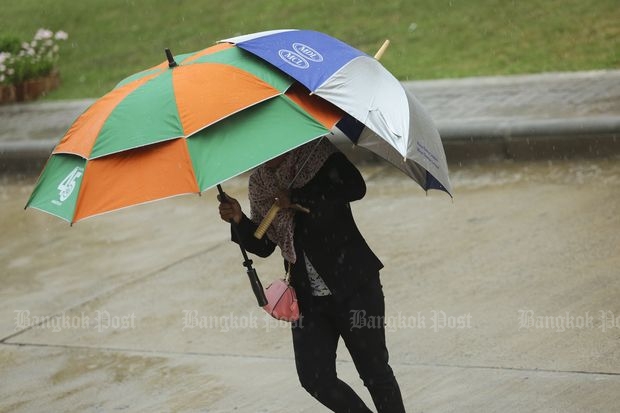
Scattered rain around Bangkok have brought much-needed relief to a long hot spell.
Rain was reported in several areas since 10am on Saturday, especially in eastern Bangkok - Lat Phrao, Chatuchak, Don Muang, Bang Khen, Sai Mai, Min Buri, Lat Krabang, Khlong Sam Wa and Nong Chok.
Blackouts were also reported in nine areas as of 5.30pm on Saturday.
All regions are now under the influence of the southeastern, northeastern and western monsoons, resulting in heavy rain everywhere, said Royon Chitdon, director of the Hydro and Agro Informatics Institute, a public organisation under the Science and Technology Ministry.
"Temperatures in Bangkok dropped from 39-40 degrees Celsius to 24-25 degrees. The pattern will continue until May 2 but there will gradually be less rain."
High pressure from China will extend furthest into Thailand on Saturday before easing.
"It will likely rain until Monday in Bangkok and until Friday for the East, Central region and Northeast, which will help ease the heat," Mr Royon said.
Early on Saturday, people complained about the heat that seemed to be more suffocating than in the previous days even though the mercury was not higher and the sky was cloudy. "This is because it was cloudy with not much sunlight and relatively high humidity," Mr Royon said.
From April 30 to May 2, the heat will ease significantly and temperature will drop more than 10 degrees Celsius.
In the provinces, three factors have contributed to heavy, damaging summer thunderstorms in recent weeks.
First, Mr Royon said now was the transition period from El Nino to La Nina.
Second, the environment in Thailand and neighbouring countries is not good, with few forests, thus low humidity and dry land.
There are also large differences between temperatures on land and at sea, causing heavy winds and storms.
Third, there are sharp differences between the highest and lowest temperatures in a day.
Citing as an example, he said in Bung Kan, the temperature was 23 degrees at dawn in one day and 43 degrees in the afternoon. The cool mass from China and South China Sea is also causing strong winds and storms.
He foresaw heavy rain again in late November but most might fall south of dams so it might not help much with drought.
Mr Royon also noted the hot weather now was not a heat wave like in India but just seasonal weather patterns because the heat was experienced only during the day.